Fez
The Fez (Turkish: fes), also called Tarboosh (Arabic: طربوش, romanized: ṭarbūš,[1] derived from Persian: سرپوش, romanized: sarpuš, lit. 'cap'), is a felt headdress in the shape of a short cylindrical peakless hat, usually red, and sometimes with a tassel attached to the top. The name "Fez" refers to the Moroccan city of Fez (capital of the Kingdom of Morocco until 1927), where the dye to colour the hat was extracted from crimson berries.[2] The modern fez owes much of its popularity to the Ottoman era.[3][4]
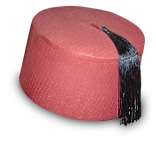
History
The origins of the Fez are unclear and there are different theories. One of them is that the Fez may have originated in the Balkans initially during the Byzantine Empire,[5] or in ancient Greece,[6][7] and subsequently spread to other places by the Ottoman Empire.
Initially the Fez was a brimless red, white, or black bonnet over which a turban was wrapped (similar to a wrapped keffiyeh). Later the turban was eliminated, the bonnet shortened, and the color fixed to red. Praying while wearing a Fez—instead of a headdress with brim—was easier because Muslims put their heads to the ground during Salah (daily prayers).[8] In the Karpass Peninsula, white caps are worn, a style considered to be based on ancient Cypriot Hellenic-Phoenician attire, thus preserving men's head-wear from 2,700 years earlier.[9]
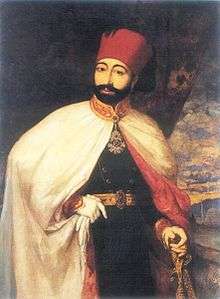
In 1826 Sultan Mahmud II of the Ottoman Empire suppressed the Janissaries and began sweeping reforms of the military. He modernized military adopted Western style uniforms and, as headdresses, the fez with a cloth wrapped around it. In 1827, 50,000 fezzes were ordered from Tunis for the sultan's troops.[10] In 1829 the Sultan ordered his civil officials to wear the plain Fez, and banned the wearing of turbans.[11] The intention was to coerce the populace at large to update to the Fez, and the plan was successful. This was a radically egalitarian measure, which replaced the elaborate sumptuary laws that signaled rank, religion, and occupation, foreshadowing the Tanzimat reforms. Although tradesmen and artisans generally rejected the Fez,[12] it became a symbol of modernity throughout the Near East, inspiring similar decrees in other nations (such as Iran in 1873).[11]
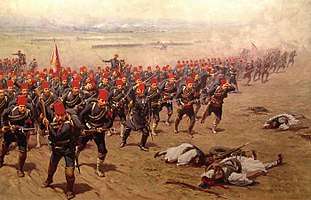
To meet escalating demand, skilled Fez makers were induced to immigrate from Tunisia to Constantinople, where factories were established in the neighborhood of Eyüp.[10] Styles soon multiplied, with nuances of shape, height, material, and hue competing in the market. The striking scarlet and merlot colors of the Fez were initially achieved through an extract of cornel. However, the invention of low-cost synthetic dyes soon shifted production of the hat to the factories of Strakonice, Czech Republic (then in the Austrian Empire).
The 1908 Austro-Hungarian annexation of Bosnia-Herzegovina resulted in a boycott of Austrian goods, which became known as the "Fez Boycott" due to the near monopoly the Austrians then held on production of the hat. Although the headdress survived, the year-long boycott brought the end of its universality in the Ottoman Empire as other styles became socially acceptable.
Symbolism
The fez was a symbol not only of Ottoman affiliation but also of religious adherence to Islam.[13] It was also the main headdress for Christians and Jews during the Ottoman Empire.[14] Jewish men wore the Fez and referred to it by the Arabic name "Tarboush", especially Arab-Jews (mostly Syrian and Palestinian).[15][16] In South-Asia, the Fez had been adopted due to its links with the Ottoman Empire.
Over time, the fez came to be seen as part of an Oriental cultural identity. Seen as exotic and romantic in the west, it enjoyed a vogue as part of men's luxury smoking outfit in the United States and the United Kingdom in the decades surrounding the turn of the 20th century. The fez had become traditional to the point that Mustafa Kemal Atatürk banned it in Turkey in 1925 as part of his modernizing reforms.[17]
Today, the fez is worn by many, most prominently in the Balkans and Morocco.[13] In Morocco, it became a more pronounced cultural symbol in the 20th-century against French dominance and it is still favoured among the royal court.[13]
Military use
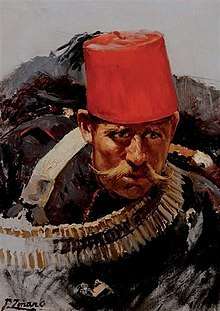

A version of the fez was used as an arming cap for the 1400–1700s version of the mail armour head protector (a round metal plate or skull-cap, around which hung a curtain of mail to protect the neck and upper shoulder). The red fez with blue tassel was the standard headdress of the Turkish Army from the 1840s until the introduction of a khaki service dress and peakless sun helmet in 1910. The only significant exceptions were cavalry and some artillery units who wore a lambskin hat with coloured cloth tops.[18] Albanian levies wore a white version of the fez, resembling their traditional qeleshe. During World War I the fez was still worn by some naval reserve units and occasionally by soldiers when off duty.[19] The Evzones (light infantry) regiments of the Greek Army wore their own distinctive version of the fez from 1837 until World War II. It now survives in the parade uniform of the Presidential Guard in Athens.
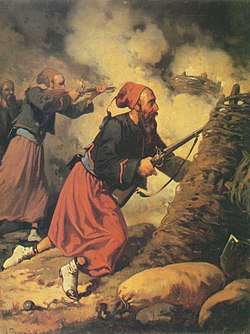
From the mid-19th century on the fez was widely adopted as the headdress of locally recruited "native" soldiers among the various colonial troops of the world. The French North African regiments (Zouaves, Tirailleurs, and Spahis) wore wide, red fezzes with detachable tassels of various colours. It was an off-duty affectation of the Zouaves to wear their fezzes at different angles according to the regiment; French officers of North African units during the 1930s often wore the same fez as their men, with rank insignia attached. (Many volunteer Zouave regiments wore the French North African version of the fez during the American Civil War.) The Libyan battalions and squadrons of the Italian colonial forces wore lower, red fezzes over white skull caps. Somali and Eritrean regiments in Italian service wore high red fezzes with coloured tassels that varied according to the unit. German askaris in East Africa wore their fezzes with khaki covers on nearly all occasions.
The Belgian Force Publique in the Congo wore large and floppy red fezzes similar to those of the French Tirailleurs Senegalais and the Portuguese Companhias Indigenas. The British King's African Rifles (recruited in East Africa) wore high straight-sided fezzes in either red or black, while the West African Frontier Force wore a low red version.[20] The Egyptian Army wore the classic Turkish model until 1950. The West India Regiment of the British Army wore a fez as part of its Zouave-style full dress until this unit was disbanded in 1928. The tradition is continued in the full dress of the band of the Barbados Regiment, with a white turban wrapped around the base.
While the fez was a colourful and picturesque item of uniform it was in several ways an impractical headdress. If worn without a drab cover it made the head a target for enemy fire, and it provided little protection from the sun. As a result, it was increasingly relegated to parade or off-duty wear by World War II, although France's West African tirailleurs continued to wear a khaki-covered version in the field until about 1943. During the final period of colonial rule in Africa (approximately 1945 to 1962) the fez was seen only as a full-dress item in French, British, Belgian, Spanish and Portuguese African units; being replaced by wide-brimmed hats or forage caps on other occasions. Colonial police forces, however, usually retained the fez as normal duty wear for indigenous personnel.
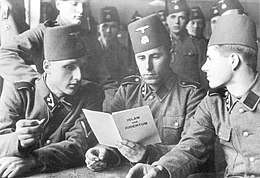
Post-independence armies in Africa quickly discarded the fez as a colonial relic. It is, however, still worn by the ceremonial Gardes Rouge in Senegal as part of their Spahi-style uniform, and by the Italian Bersaglieri in certain orders of dress. The Bersaglieri adopted the fez as an informal headdress through the influence of the French Zouaves, with whom they served in the Crimean War. The Italian Arditi in the First World War wore a black fez that later became a uniform item of the Mussolini Fascist regime.[21] The Spanish Regulares (formerly Moorish) Tabors stationed in the Spanish exclaves of Ceuta and Melilla, in North Africa, retain a parade uniform that includes the fez and white cloaks. Filipino units organised in the early days of U.S. rule briefly wore black fezzes and officers serving with Muslim personnel of the Philippines Constabulary were authorized to wear this headdress from 1909.[22] The Liberian Frontier Force, although not a colonial force, wore fezzes until the 1940s.
Bosnian infantry regiments in the former Austro-Hungarian Empire had been distinguished by wearing the fez until the end of World War I. They wore distinctive light blue or field grey uniforms,[23] with a buckle showing an arm with a scimitar inside a shield as the symbol of Bosniak ethnicity. The largely Bosniak Muslim 13th Waffen Mountain Division of the SS Handschar, which was recruited from Bosnia, used a red or field grey fez with Waffen SS cap insignia during the latter half of World War II.
Two regiments of the Indian Army recruited from Muslim areas wore fezzes under British rule (although the turban was the nearly-universal headdress among Hindu and Muslim sepoys and sowars). A green fez was worn by the Bahawalpur Lancers of Pakistan as late as the 1960s.[24]
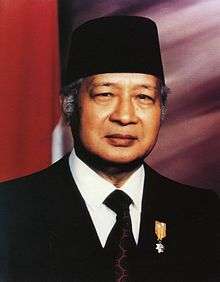
International use
In the Middle East and North Africa
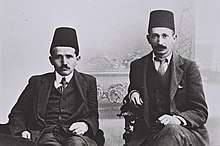
It is believed that the chechia originated in Uzbekistan. Unlike the fez, the chechia is shorter, and crafted from less stiff material, and is therefore softer and more pliable. By the 17th century that the chaouachis, or chechia makers, had spread to the capital Tunis, the capital of Tunisia. By the 21st century, the procedure for making them remains the same, but the number of craftsmen who make them has decreased. While the market place in the Souk Ech-Chaouachine, hosted about 30,000 chaouachis during at its peak, that number had dropped by the 2010s to about 20, who struggle to keep the business alive. The modern chechia business is estimated to create jobs for over 2,000 artisans, with the remaining chechias are sold overseas, primarily to Libya, Nigeria and Niger. Chechia colours vary by country. It is red in Tunisia, and lacks a tassel. In Libya, the chechia is normally black, except the Benghazi version, or "chenna", which is also red, and includes a tassel. In Morocco, and in some parts of Tunisia, it can also be seen in white or grey.[25]
In Southern Asia

The fez is known as the Rumi Topi, which means "Headdress of Rome" (By virtue of the Ottoman Empire being seen as the successor state of the Eastern Roman Empire). It is worn by some sections of the Muslim aristocracy of South Asia. It was also a symbol of the support for the Ottoman Caliphate against the British Indian Empire during the Khilafat Movement. Later, it became associated with some leaders of the Muslim League, the political party that eventually created the country of Pakistan. The veteran Pakistani politician Nawabzada Nasrullah Khan was one of the few people in Pakistan who wore the fez, until his death in 2003.
In Sri Lanka, the fez was frequently worn by the local Muslim Sri Lankan Moor population, as their ancestry descends from the Moors. Despite its use declining in popularity, the fez is still used in traditional marriage ceremonies. It continues to be worn by "Qadiriyathun Nabaviyyah" Sufi path followers. The songkok, on the other hand, is worn by the local Sri Lankan Malays.
A variation of the fez has been commonly worn in Maritime Southeast Asia since the 19th century when it was introduced by Muslims from South Asia. Known as a peci in Indonesian and songkok in Malaysian, this variant is black in colour with a more ellipse shape and sometimes decorated with embroidery. The Philippine varieties tend to be colorful and highly decorated.
Use by fraternal orders
Many fraternal orders are known for wearing fezzes.[26] Shriners are often depicted wearing a red fez; the headgear became official for the Shriners in 1872.[27] International Order of Alhambra wear a white fez. Mystic Order of Veiled Prophets of the Enchanted Realm members wear a black fez. Knights of Peter Claver wear a blue fez. The Ancient Mystic Order of Samaritans wear various colors of fezzes, based upon rank. The Knights of Khorassan wear a navy blue fez. The Improved Benevolent and Protective Order of Elks of the World wear various colors of fezzes, based upon rank. The Loyal Order of Moose's second degree body, the Moose Legion, wear a purple fez. In the Laurel and Hardy film Sons of the Desert members of the fictional order of the same name wear fezzes, and consequently so do those of the Laurel and Hardy International Appreciation Society, which is itself named after and modelled on the one seen in the film. In Doctor Who, some characters wear fezes, including the Eleventh Doctor (Matt Smith.
See also
- Kalpak – a similar Turkic head cap
- Moorish Science Temple of America
- Smoking cap
- Songkok – truncated conical felt hat in Southeast Asia
- Taqiyah and Kufi – brimless rounded cap
- Qeleshe – a white rounded cap worn by Albanians
- Fez (video game)
- Tommy Cooper
- List of headgear
- Cap
- Eleventh Doctor/Thirteenth Doctor – The 11th and 13th incarnations of the titular character from British science fiction drama Doctor Who, who demonstrate a fondness for fezzes.
References
- Hans Wehr, Dictionary of Modern Written Arabic, 4th ed., page 649.
- "History of the Fez | Iconic Hats | Village Hats".
- Amphlett, Hilda (2003). Hats: a history of fashion in headwear. Mineola, New York: Courier Dover.
- Kaya, Ibrahim (2004). Social theory and later modernities: the Turkish experience. Liverpool, England: Liverpool University Press. p. 119.
- "Fez Journal; Last Refuge of the Tall Tasseled Ottoman Hat". The New York Times. 22 March 1995. Retrieved 8 March 2019.
- Hilda Amphlett (2012). Hats: A History of Fashion in Headwear. Courier Corporation. p. 12. ISBN 978-0486136585.
- Ruth Turner Wilcox (2013). The Mode in Hats and Headdress: A Historical Survey with 198 Plates. Courier Corporation. p. 33. ISBN 978-0486318301.
- Kinross, Lord (1979). The Ottoman Centuries. Perennial. p. 466. ISBN 978-0-688-08093-8.
- "The Traditional Costumes of Cyprus". Noctoc. January 2008.
- Philip Mansel (10 November 2011). Constantinople: City of the World's Desire, 1453-1924. John Murray Press. p. 251. ISBN 978-1-84854-647-9.
- Jirousek, Charlotte (2005). "Islamic Clothing". Encyclopedia of Islam. New York: Macmillan.
- Quataert, Donald (August 1997). "Clothing Laws, State, and Society in the Ottoman Empire, 1720–1829". International Journal of Middle East Studies. 29 (3): 403–25. doi:10.1017/s0020743800064837. JSTOR 164587.
- Mark Juergensmeyer; Wade Clark Roof (2012). Encyclopedia of Global Religion. SAGE. p. 402. ISBN 978-0-7619-2729-7.
- "Jewish Community in Ottoman Empire". DailySabah.
- Bywater, Maria (30 July 2014). "The Fabric of Jewish History: Ottoman Jews". Sew Jewish.
- "April 1897 - Jaffa Gate in Jerusalem (speed corrected w/ added sound)". 6 October 2018.
- Deringil, Selim (January 1993). "The Invention of Tradition as Public Image in the Late Ottoman Empire, 1808 to 1908". Comparative Studies in Society and History. 35 (1): 9.
- Knotel, Richard (January 1980). Uniforms of the World. A Compendium of Army, Navy and Air Force Uniforms 1700-1937. pp. 430–433. ISBN 0-684-16304-7.
- Nicolle, David (28 March 1994). The Ottoman Army 1914-18. pp. 44 & 47. ISBN 1-85532-412-1.
- Rinaldo D'Ami, pages 53 & 59 "World Uniforms in Colour", Volume 2, Casa Editrice AMZ Milqn 1966 SBN 85059 X.
- Elioe Vittorio, tavola XLVI "Atlante dell Uniformi: military italians dal 1934 ad oggi", Ermanno Albertelli 1984.
- Elting, Col John R. (1988). Military Uniforms in America. The Modern Era from 1868. p. 40. ISBN 0-89141-292-1.
- Neumayer, Christoh. The Emperor's Bosniaks. p. 199. ISBN 978-3-902526-17-5.
- Rinaldo D'Ami, page 72 "World Uniforms in Colour", Volume 2, Casa Editrice AMZ Milqn 1966 SBN 85059 X.
- Petre, Christine (April 27, 2015). "Will Tunisia's chechia hat survive into future years?". Middle East Eye.
- "The Fez Museum - Dedicated to Fraternal Fez Hats". www.fezmuseum.com.
- "Shriners International: History: The Fez". Shriners International. Retrieved 23 April 2015.
External links
![]()